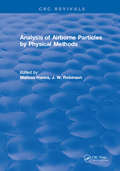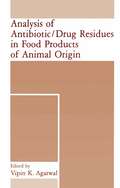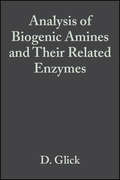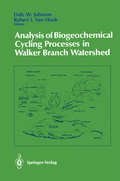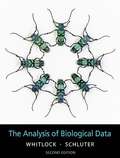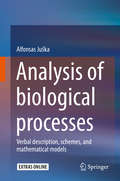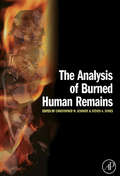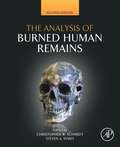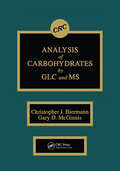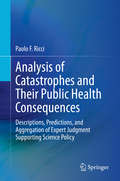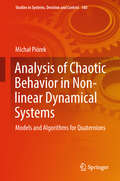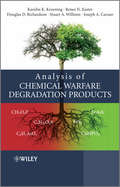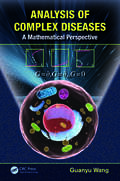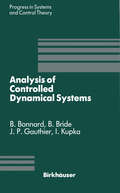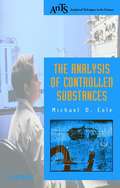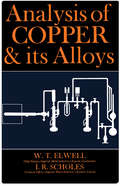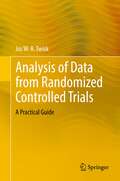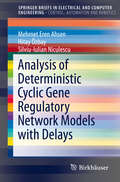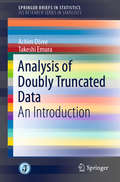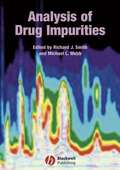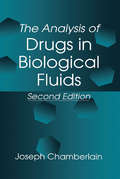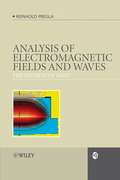- Table View
- List View
Analysis of Airborne Particles by Physical Methods
by Malissa HannsAn accurate and complete characterization of the solid pollutants in air, taking into account the physio-chemical and technological data available concerning the origin, transformation, and the effects of dust, is a synoptic approach known as SISintegrated dust analysis and is the underlying concept of this book.
Analysis of Antibiotic/Drug Residues in Food Products of Animal Origin
by V. K. AgarwalIn the last three decades. use of antibiotics/drugs in animal husbandry programs has grown tremendously. Antibiotics/drugs are used therapeutically to cure diseases. and subtherapeutically to control the outbreak of diseases, improve feed efficiency and promote growth. The presence of antibiotic/drug residues in food products of animal origin. i.e •• meat, poultry and milk, can be a potential health hazard to consumers. Significant research is being done to develop new methods or to improve on existing methods to confirm and quantitatively determine the antibiotic/drug residues in meat, poultry and milk. This book covers recent development and application of various analytical techniques for the determination of antibiotic/drug residues in food products of animal origin. I thank the authors for their time and efforts in preparing the manuscripts and "all the reviewers for reviewing the manuscripts. I also thank to the Division of Agricultural and Food Chemistry of the American Chemical Society for sponsoring the symposium and Hewlett Packard, Palo Alto, CA, Perkin Elmer Corp., Norwalk, CT, Millipore Corporation, Milford, MA, and Kraft General Foods, Glenview, IL, for their generous financial support for the symposium. Vipin K. Agarwal New Haven, CT v CONTENTS Importance of Laboratory Validations and Accurate Descriptions of Analytical Procedures for Drug Residues in Foods ................. .
Analysis of Biogenic Amines and Their Related Enzymes (Methods of Biochemical Analysis #117)
by David GlickBiochemical analysis is a rapidly expanding field and is a key component of modern drug discovery and research. Methods of Biochemical Analysis provides a periodic and authoritative review of the latest achievements in biochemical analysis. Founded in 1954 by Professor David Glick, Methods of Biochemical Analysis provides a timely review of the latest developments in the field.
Analysis of Biogeochemical Cycling Processes in Walker Branch Watershed (Springer Advanced Texts in Life Sciences)
by Dale W. Johnson Robert I. Van HookThe Oak Ridge National Laboratory's Environmental Sciences Division initiated the Walker Branch Watershed Project on the Oak Ridge Reservation in east Tennessee in 1967, with the support of the U. S. Department of Energy's Office of Health and Environmental Research (DOE/OHER), to quantify land-water interactions in a forested landscape. It was designed to focus on three principal objectives: (1) to develop baseline data on unpolluted ecosystems, (2) to contribute to our knowledge of cycling and loss of chemical elements in natural ecosystems, and (3) to provide the understanding necessary for the construction of mathe matical simulation models for predicting the effects of man's activities on forested landscapes. In 1969, the International Biological Program's Eastern Deciduous Forest Biome Project was initiated, and Walker Branch Watershed was chosen as one of several sites for intensive research on nutrient cycling and biological productivity. This work was supported by the National Science Foundation (NSF). Over the next 4 years, intensive process-level research on primary productivity, decomposition, and belowground biological processes was coupled with ongoing DOE-supported work on the characterization of basic geology and hydrological cycles on the watershed. In 1974, the NSF's RANN Program (Research Applied to National Needs) began work on trace element cycling on Walker Branch Wa tershed because of the extensive data base being developed under both DOE and NSF support.
The Analysis of Biological Data, Second Edition
by Michael C. Whitlock Dolph SchluterThis second edition textbook teaches modern methods of statistics through the use of fascinating biological and medical case studies. The clear and engaging writing and practical perspective allows students to understand the analytical process behind biological data. Through the use of real world biological examples, biologists and health professionals can learn statistics in an essential manner.
Analysis of biological processes: Verbal description, schemes, and mathematical models
by Alfonsas JuškaThe main concern of the book is analysis of biological processes, the final stage of which is mathematical modeling, i.e. quantitative presentation of the processes in rigorous mathematical terms. It is designated for non-mathematicians. Mathematical models can be compared with experimental data thus verifying the validity of the models and finally of the initial assumptions and verbal descriptions of the processes. The models (usually in the form of mathematical equations) are achieved painlessly via the schemes summarising verbal description of what is known concerning the processes. To solve the equations computer software is used. The step-by-step analysis leads to quite sophisticated models some of them being original. The book helps the reader to develop more general approach to the problems. It may be useful for experienced readers as well.
The Analysis of Burned Human Remains (Atlas Of Surgical Pathology Ser.)
by Steven A. Symes Christopher W. SchmidtThis unique reference provides a primary source for osteologists and the medical/legal community for the understanding of burned bone remains in forensic or archaeological contexts. It describes in detail the changes in human bone and soft tissues as a body burns at both the chemical and gross levels and provides an overview of the current procedures in burned bone study. Case studies in forensic and archaeological settings aid those interested in the analysis of burned human bodies, from death scene investigators, to biological anthropologists looking at the recent or ancient dead.Includes the diagnostic patterning of color changes that give insight to the severity of burning, the positioning of the body, and presence (or absence) of soft tissues during the burning eventChapters on bones and teeth give step-by-step recommendations for how to study and recognize burned hard tissues
The Analysis of Burned Human Remains
by Steven A. Symes Christopher W. SchmidtThe Analysis of Burned Human Remains, Second Edition, provides a primary source for osteologists and the medical/legal community for the understanding of burned bone remains in forensic or archaeological contexts. It describes in detail the changes in human bone and soft tissues as a body burns at both the chemical and gross levels and provides an overview of the current procedures in burned bone study. Case studies in forensic and archaeological settings aid those interested in the analysis of burned human bodies, from death scene investigators to biological anthropologists.A timely state-of-the-art analyses of burned bone studies for bioarchaeologists and forensic anthropologistsCovers the diagnostic patterning of color changes, the positioning of the body, and presence (or absence of soft tissues during the burning eventChapters on bones and teeth give step-by-step recommendations for hot to study and recognize burned hard tissuesNew chapters include improved analyses of thermally induced impacts on bone microstructure, development, and appearance; they also cover sites from a greater geographic range adding Alaska, Italy, Jordan, Mexico, and Southeast Asia
Analysis of Carbohydrates by GLC and MS
by Christopher J. Biermann Gary D. McGinnisThis textbook is a comprehensive guide to analysis of carbohy-drates by gas-liquid chromatography and mass spectrometry. In addition to explaining the facets of carbohydrate analysis and their relation to each other, the text also contains in-depth reference in-formation useful to practitioners in the field. Improvements in car-bohydrate analyses methodology during the past six years are also highlighted. This extensively illustrated text provides excellent data for those in carbohydrate, agriculture, and food chemistry.
Analysis of Carbohydrates by GLC and MS
by Christopher J. Biermann Gary D. McGinnisThis textbook is a comprehensive guide to analysis of carbohy-drates by gas-liquid chromatography and mass spectrometry. In addition to explaining the facets of carbohydrate analysis and their relation to each other, the text also contains in-depth reference in-formation useful to practitioners in the field. Improvements in car-bohydrate analyses methodology during the past six years are also highlighted. This extensively illustrated text provides excellent data for those in carbohydrate, agriculture, and food chemistry.
Analysis of Catastrophes and Their Public Health Consequences: Descriptions, Predictions, and Aggregation of Expert Judgment Supporting Science Policy
by Paolo F. RicciPublic health policy prospectively and retrospectively addresses the consequences of events ranging from the commonplace to the catastrophic. Informing policymakers and stakeholders by enhancing their understanding of complex causation to justify remedial or precautionary actions is a critical science-policy task. In this book, the key aspects of catastrophes (regardless of their nature) and routine events are identified through a common framework for their analyses, and the analyses of the consequences associated with the potential occurrence of these events also are discussed. The book is not about disaster planning; instead, it is focused on analysis and causation in the context of informing – rather than formulating – public health policy. The author aggregates and fuses scientific information and knowledge in public health policy-science using alternative but complementary methods. The book first focuses on the analysis of catastrophes and commonplace events; the focus then shifts to causal models of multifactorial diseases, particularly at low doses or dose-rates, associated with these events. Topics explored among the chapters include:Policy and Legal Aspects of Precautionary ChoicesCatastrophes, Disasters, and Calamities: Concepts for Their Assessment Uncertainty: Probabilistic and Statistical AspectsAggregating Judgments to Inform Precautionary Decision-makingThe aim of the book is to show that the analyses of events are fundamentally similar, regardless of whether the concern is a global catastrophe or commonplace. Analysis of Catastrophes and Their Public Health Consequences is a text that should engage students, instructors, and researchers in public health, science policy, and preparedness research, as well as serve as a useful resource for policy analysts, practitioners, and risk managers.
Analysis of Chaotic Behavior in Non-linear Dynamical Systems: Models and Algorithms for Quaternions (Studies in Systems, Decision and Control #160)
by Michał PiórekThis book presents a new approach for the analysis of chaotic behavior in non-linear dynamical systems, in which output can be represented in quaternion parametrization. It offers a new family of methods for the analysis of chaos in the quaternion domain along with extensive numerical experiments performed on human motion data and artificial data. All methods and algorithms are designed to allow detection of deterministic chaos behavior in quaternion data representing the rotation of a body in 3D space. This book is an excellent reference for engineers, researchers, and postgraduate students conducting research on human gait analysis, healthcare informatics, dynamical systems with deterministic chaos or time series analysis.
Analysis of Chemical Warfare Degradation Products
by Karolin K. Kroening Renee N. Easter Douglas D. Richardson Stuart A. Willison Joseph A. CarusoThis book describes nerve agents and vesicants, their decomposition and their degradation products' chemistry as well as their toxicity including a list of detection techniques of nerve agents and their degradation products. This book will present their history, toxicity, comparison between different sample preparation methods, separation techniques, and detection methods all together in a short, easy to read book, tied together by a single group doing the writing and the editing to assure smooth transition from chapter to chapter, with sufficient Tables and literature references for the reader who looks to further detail.The text will illustrate the pluses and minuses of the various techniques with sufficient references for the reader to obtain extensive detail.
Analysis of Chemical Warfare Degradation Products
by Karolin K. Kroening Renee N. Easter Douglas D. Richardson Stuart A. Willison Joseph A. CarusoThis book describes nerve agents and vesicants, their decomposition and their degradation products' chemistry as well as their toxicity including a list of detection techniques of nerve agents and their degradation products. This book will present their history, toxicity, comparison between different sample preparation methods, separation techniques, and detection methods all together in a short, easy to read book, tied together by a single group doing the writing and the editing to assure smooth transition from chapter to chapter, with sufficient Tables and literature references for the reader who looks to further detail.The text will illustrate the pluses and minuses of the various techniques with sufficient references for the reader to obtain extensive detail.
Analysis of Complex Diseases: A Mathematical Perspective
by PhD, Guanyu WangA complex disease involves many etiological and risk factors operating at multiple levels-molecular, cellular, organismal, and environmental. The incidence of such diseases as cancer, obesity, and diabetes are increasing in occurrence, urging us to think fundamentally and use a broader perspective to identify their connection and revolutionize trea
Analysis of Controlled Dynamical Systems: Proceedings of a Conference held in Lyon, France, July 1990 (Progress in Systems and Control Theory #8)
by B. Bonnard B. Bride J. P. Gauthier I. KupkaThe conference "Analysis of Controlled Dynamical Systems" was held in July 1990 at the University of LYON FRANCE. About hundred participants attended this conference which lasted four days : There were 50 speakers from departments of Engineering and Mathematics in east and west Europe, USA and USSR. The general subject of the conference was system theory. The main topics were optimal control, structure and control of nonlinear systems, stabilization and observers, differential algebra and systems theory, nonlinear aspects of Hoc theory, rigid and flexible mechanical systems, nonlinear analysis of signals. We are indebted to the scientific committee John BAILLIEUL, Michel FLIESS, Bronislaw JAKUBCZYCK, Hector SUSSMANN, Jan WILLEMS. We gratefully acknowledge the time and thought they gave to this task. We would also like to thank Chris BYRNES for arranging for the publication of these proceedings through the series "Progress in Systems and Control Theory"; BIRKHAUSER. Finally, we are very grateful to the following institutions who through their financial support contributed essentially to the success of this conference : CNRS, Special year " Systemes Dynamiques", DRET, MEN-DAGIC, GRECO-AUTOMATIQUE, Claude Bernard Lyon I University, Entreprise Rhone-Alpes International, Conseil General du RhOne, the cities of LYON and VILLEURBANNE.
The Analysis of Controlled Substances (Analytical Techniques in the Sciences (AnTs) *)
by Michael D. ColePresenting new developments in sampling and drug profiling, this book also provides practical information on how to carry out analysis, what the results mean and how they can be used as court evidence and for drugs intelligence purposes. * Includes case-studies with full data and spectra, helping readers to identify substances * Accessibly organized by class of compound * Contains an up-to-date list of the newest drugs
Analysis of Copper and Its Alloys
by W. T. Elwell I. R. ScholesAnalysis of Copper and Its Alloys provides important information for the satisfactory analysis of typical industrial products. This book presents several instrumental methods for analysis, which involve the use of instruments that are familiar, even in small laboratories. Organized into 34 chapters, this book starts with an overview of the various factors that are common to most methods of sampling copper-base materials, regardless of the quality and quantity of material to be sampled. This text then discusses the safety precautions pertaining to the handling of reagents and apparatus. Other chapters consider the factors that influence the determination when copper is electrolytically deposited in the conventional way, including the simultaneous co-deposition of other metals, the retention of copper, and the inhibiting effect of metals. This book discusses as well the presence of refractory tin oxide in tin-bearing alloys. This book is a valuable resource for chemists, teachers, students, and researchers.
Analysis of Data from Randomized Controlled Trials: A Practical Guide
by Jos W.R. TwiskThis book provides a practical guide to the analysis of data from randomized controlled trials (RCT). It gives an answer to the question of how to estimate the intervention effect in an appropriate way. This problem is examined for different RCT designs, such as RCTs with one follow-up measurement, RCTs with more than one follow-up measurement, cluster RCTs, cross-over trials, stepped wedge trials, and N-of-1 trials. The statistical methods are explained in a non-mathematical way and are illustrated by extensive examples. All datasets used in the book are available for download, so readers can reanalyse the examples to gain a better understanding of the methods used. Although most examples are taken from epidemiological and clinical studies, this book is also highly recommended for researchers working in other fields.
Analysis of Deterministic Cyclic Gene Regulatory Network Models with Delays (SpringerBriefs in Electrical and Computer Engineering)
by Mehmet Eren Ahsen Hitay Özbay Silviu-Iulian NiculescuThis brief examines a deterministic, ODE-based model for gene regulatory networks (GRN) that incorporates nonlinearities and time-delayed feedback. An introductory chapter provides some insights into molecular biology and GRNs. The mathematical tools necessary for studying the GRN model are then reviewed, in particular Hill functions and Schwarzian derivatives. One chapter is devoted to the analysis of GRNs under negative feedback with time delays and a special case of a homogenous GRN is considered. Asymptotic stability analysis of GRNs under positive feedback is then considered in a separate chapter, in which conditions leading to bi-stability are derived. Graduate and advanced undergraduate students and researchers in control engineering, applied mathematics, systems biology and synthetic biology will find this brief to be a clear and concise introduction to the modeling and analysis of GRNs.
Analysis of Doubly Truncated Data: An Introduction (SpringerBriefs in Statistics)
by Takeshi Emura Achim DörreThis book introduces readers to statistical methodologies used to analyze doubly truncated data. The first book exclusively dedicated to the topic, it provides likelihood-based methods, Bayesian methods, non-parametric methods, and linear regression methods. These procedures can be used to effectively analyze continuous data, especially survival data arising in biostatistics and economics. Because truncation is a phenomenon that is often encountered in non-experimental studies, the methods presented here can be applied to many branches of science. The book provides R codes for most of the statistical methods, to help readers analyze their data. Given its scope, the book is ideally suited as a textbook for students of statistics, mathematics, econometrics, and other fields.
Analysis of Drug Impurities (Sheffield Analytical Chemistry Series)
by Richard J. Smith Michael L. WebbA key component of the overall quality of a pharmaceutical is control of impurities, as their presence, even in small amounts, may affect drug safety and efficacy. The identification and quantification of impurities to acceptable standards presents a significant challenge to the analytical chemist. Analytical science is developing rapidly and provides increasing opportunity to identify the structure, and therefore the origin and safety implications of these impurities, and the challenges of their measurement drives the development of modern quantitative methods. Written for both practicing and student analytical chemists, Analysis of Drug Impurities provides a detailed overview of the challenges and the techniques available to permit accurate identification and quantification of drug impurities.
The Analysis of Drugs in Biological Fluids
by Joseph ChamberlainThis new edition focuses on a variety of techniques available for the analysis of drugs in biological fluids. Over 150 figures and tables help to describe the latest advances and give examples of their applications. Current chiral analysis methods as well as discussions on the impact of chirality are described. Practical aspects of bioanalytical work, including many examples of laboratory problems not often reported in the scientific literature, are examined in depth.
The Analysis of Drugs in Biological Fluids
by Joseph ChamberlainThis new edition focuses on a variety of techniques available for the analysis of drugs in biological fluids. Over 150 figures and tables help to describe the latest advances and give examples of their applications. Current chiral analysis methods as well as discussions on the impact of chirality are described. Practical aspects of bioanalytical work, including many examples of laboratory problems not often reported in the scientific literature, are examined in depth.
Analysis of Electromagnetic Fields and Waves: The Method of Lines (RSP #21)
by Reinhold PreglaThe Method of Lines (MOL) is a versatile approach to obtaining numerical solutions to partial differential equations (PDEs) as they appear in dynamic and static problems. This method, popular in science and engineering, essentially reduces PDEs to a set of ordinary differential equations that can be integrated using standard numerical integration methods. Its significant advantage is that the analysis algorithms follow the physical wave propagation and are therefore efficient. This is because the fields on the discretisation lines are described by generalised transmission line (GTL) equations. With this formulation we have a connection to the well known transmission line theory and resulting in an easy understanding. The method of lines is a very accurate and powerful way to analyze electromagnetic waves, enabling a full-wave solution without the computational burden of pure finite element or finite difference methods. With Analysis of Electromagnetic Fields and Waves, Reinhold Pregla describes an important and powerful method for analyzing electromagnetic waves. This book: Describes the general analysis principles for electromagnetic fields. Includes applications in microwave, millimetre wave and optical frequency regions. Unifies the analysis by introducing generalised transmission line (GTL) equations for all orthogonal coordinate systems and with materials of arbitrary anisotropy as a common start point. Demonstrates a unique analysis principle with the numerical stable impedance/admittance transformation and a physical adapted field transformation concept that is also useful for other modelling algorithms. Includes chapters on Eigenmode calculations for various waveguides, concatenations and junctions of arbitrary number of different waveguide sections in complex devices, periodic structures (e.g. Bragg gratings, meander lines, clystron resonators, photonic crystals), antennas (e.g. circular and conformal). Enables the reader to solve partial differential equations in other physical areas by using the described principles. Features an accompanying website with program codes in Matlab© for special problems. Analysis of Electromagnetic Fields and Waves will appeal to electromagnetic field practitioners in primary and applied research as well as postgraduate students in the areas of photonics, micro- and millimetre waves, general electromagnetics, e.g. microwave integrated circuits, antennas, integrated and fibre optics, optoelectronics, nanophotonics, microstructures, artificial materials.
